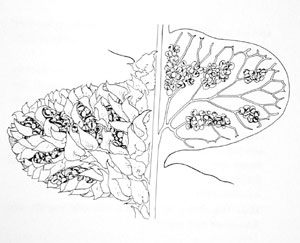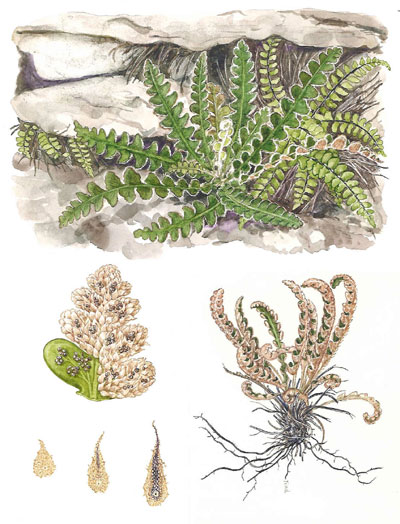| Asplenium ceterach | ||
Rustyback, Scale fern | ||
|
Etymology
The word ceterach comes from an Arabic word applied to the plant by Persian physicians
Description
Rhizome: erect, branching, scales clathrate.
Frond: 15 cm high by 2 cm wide, evergreen, monomorphic, blade/stipe ratio: 8:1. Stipe: green, from base all up the rachis, scaly, vascular bundles: 2 C-shaped, back to back, uniting to 1 upwards to an X-shape. Blade: pinnatifid, lanceolate, leathery, deep green upper surface, scales dense, light brown, entirely covering the lower surface. Pinnae: 6 to 12 pair, alternate; margins entire or sometimes irregularly crenate, slightly bending upwards, revealing the scales; veins netted, veins closing near the margins, not visible without removing the scales. Sori: linear, along veins, indusium: vestigial, replaced by scales, sporangia: dark brown, maturity: late summer, then overwintering to maturity early . Dimensionality: a rosette, fairly flat on the ground. Culture
Habitat: on limestone substrates.
Distribution: maritime and southern Europe, northern Africa, east to the Himalayas.
Hardy to -25°C, USDA Zone 5.
Distinctive Characteristics
The densely scaly lower surface and the pinnatifid form make this unique. Demands a site with excellent drainage, and can withstand drying out in the manner of some polypodies.
Synonyms
Ceterach officinarum DC. |
|
|
|
Asplenium ceterach , clathrate scale BioImages: The Virtual Field-Guide (UK), photo © Malcolm Storey. |

Asplenium ceterach. Two pinnae, scales removed on upper one to show venation and sori. Illustration from Scandinavian Ferns by Benjamin Øllgaard and Kirsten Tind, Rhodos, 1993. |
